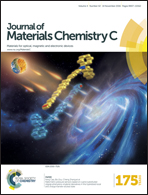Enhancement of optical gain characteristics of quantum dot films by optimization of organic ligands†
Abstract
This work examines how the optimization of molecular dimensions and chemical functionality of the organic ligands of quantum dots (QDs) can be explored for dramatic enhancement of the optical properties of QD films, particularly, optical gain. We show that the replacement of traditional QD organic ligands with a much shorter ligand, butylamine, yields a dense QD-packing that results in a two-fold increase in optical gain. Overall, the highly packed QD films exhibit very large net gain values (∼500 cm−1) which greatly exceed typical Cd-based QD films with traditional ligands. In addition, thresholds for amplified-spontaneous emission (ASE) down to 50 μJ cm−2 were observed, which is exceptionally low for ns-pulse pumped QD systems. Our results confirm an additional route for obtaining high optical gain using QDs, and outline a strategy for modifying the optical gain characteristics by ligand exchange without needing to modify the QD selection. Consideration of the ligands along with QD compositional design could make it possible to fabricate photonic systems with exceptionally low lasing thresholds, and offers a route toward achieving high gain using steady state pumping, an extremely difficult feat to achieve in traditional QD systems.


 Please wait while we load your content...
Please wait while we load your content...